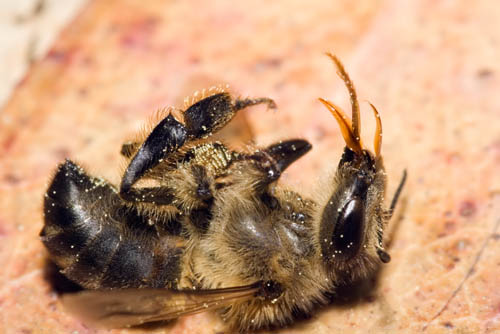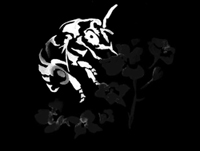Detecting pollinator poisoning
Detection: The most obvious signs of poisoning are piles of dead and dying bees near hives. There may also be a sudden drop in hive numbers as foragers leave and do not return. A normal death rate for a colony is about 100 adults per day; if a beekeeper observes more than 200-400 dead bees, it may be cause for concern.

Other symptoms of poisoning include dead brood in the hive, fewer nurse bees and a decline in brood care. Surviving bees will remove dead adults and brood and deposit them outside the hive, and these can be indicative of a problem.
It can be more difficult to detect sublethal poisonings, which can lead to impaired movement, reduced navigation and/or learning ability, etc. Symptoms may include unusual aggressiveness, including confusion and fighting at the hive entrance as recognition of nestmates is impaired. Poisoned adults bees may appear sluggish or paralyzed, unable to fly or crawl properly and resting on nearby objects or lying on the ground. Some insecticides (organophosphates) can cause regurgitation of collected nectar from the honey stomach ("wet bees";). It should be noted that many of these symptoms can have causes other than pesticide poisoning, such as plants with toxic nectar and certain bee paralysis viral diseases, and therefore a toxicological analysis is imperative, particularly if compensation for damages may be sought.
For more details on the symptoms of specific insecticides, see “Types of Pesticides”.
Loss of managed solitary bees is usually not as obvious, although females will be conspicuously absent from the domicile area and males may appear confused by their absence.
Arranging for toxicological analysis: If a poisoning incident is suspected, beekeepers and growers can arrange for chemical analysis of bees or hive products to detect pesticide residues. There are commercial laboratories willing to perform analyses, but often for a considerable fee.
It is important to collect a sample of as many dead or sickened bees as quickly as possible. The bees should be collected in front of a third-party witness. The samples should be preserved in the freezer until they can be submitted for analyses. Record the date, actions taken, pesticides used, and weather conditions during and after the suspected pesticide application occurred.
In Ontario, bees are analyzed for pesticides through OMAFRA at Laboratory Services Division, University of Guelph, 95 Stone Road West, Guelph, ON, N1H 8J7. Contact information and other details can be found here: http://www.omafra.gov.on.ca/english/food/inspection/bees/info_analysis.htm.
A suspected poisoning incident should also be reported to the Office of the Provincial Apiarist (1-888-466-2372 ext. 63595; paul.kozak@ontario.ca). If possible, consult the laboratory that will be performing the analysis for more specific instructions, including minimum sample size and storage protocols. Pesticides may accumulate in hive materials (stored pollen, wax, etc) or products (honey), but a positive result will be very difficult to link with a particular suspected incident.
Selected References
Decourtye, A., Armengaud, C., Renou, M., Devillers, J., Cluzeau, S., Gauthier, M., & Pham-Delegue, M.H. 2004. Imidacloprid impairs memory and brain metabolism in the honeybee (Apis mellifera L.). Pesticide Biochemistry and Physiology 78:83-92.
Johansen, C. 1977. Pesticides and pollinators. Annual Review of Entomology 22:177-192.
Johansen, C. 1984. How to reduce bee poisoning from pesticides. Government of Alberta Agriculture and Rural Development AgDex 616-5. Edmonton AB.
Riedl, H., Johansen, E., Brewer, L., & Barbour, J. 2006. How to reduce bee poisoning from pesticides. Pacific Northwest Cooperative Extension Publication #PNW 591.
Scott-Dupree, C.D., Winston, M., Hergert, G., Jay, S.C., Nelson, D., Gates, J., Termeer, B., & Otis, G. 1995. A guide to managing bees for crop pollination. Canadian Association of Professional Apiculturists, Aylesford NS.
